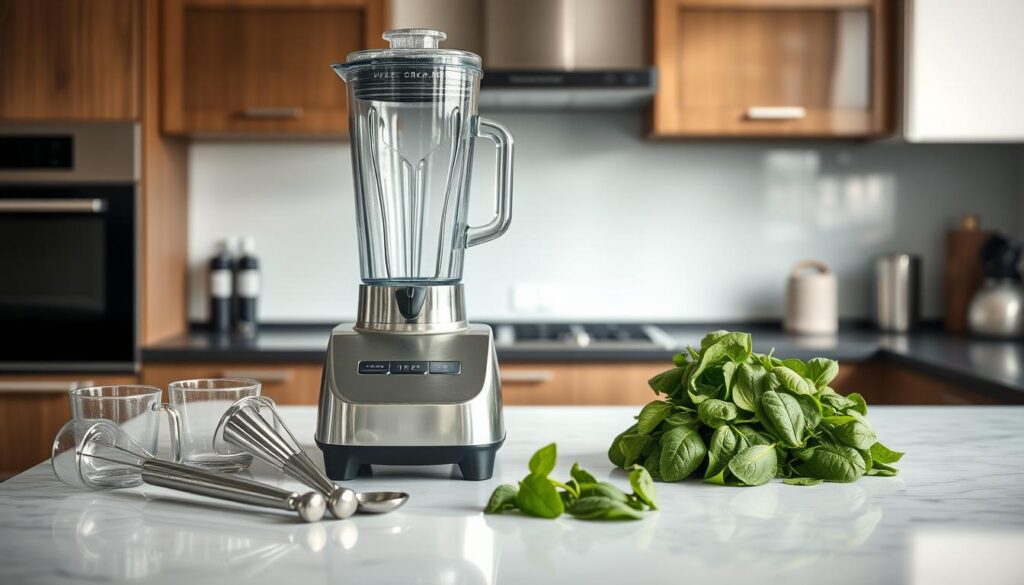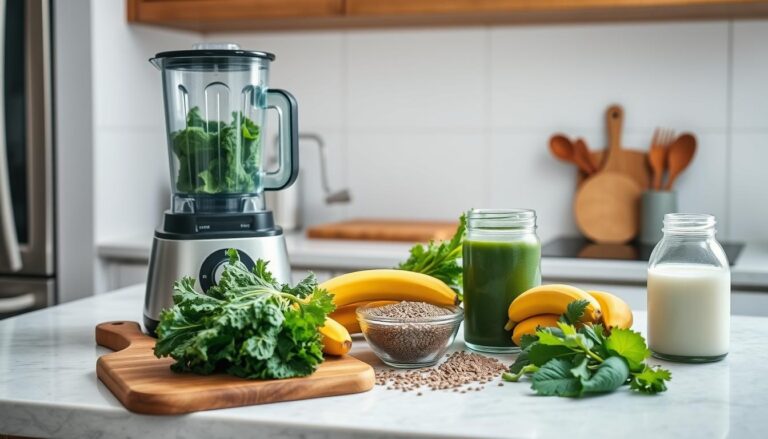Can a green drink taste fresh, sweet, and utterly satisfying while still being 100% plant-based?
This quick recipe shows you how. Start with raw spinach, pineapple or banana, and almond milk for a creamy base that masks greens without hiding nutrients.
Frozen fruit often beats store “fresh” because it is frozen within hours of picking, locking in vitamins. Use raw spinach in the blender for the best texture. Blend on high about 40–60 seconds for silky results.
You’ll learn which ingredients work, how to load your blender, and simple swaps like soy or oat milk. Drink immediately for peak nutrition, or seal and refrigerate up to 12–24 hours and shake before sipping.
Ready to customize? Try our smoothie pairings and then build your own with the Smoothie Generator: Use the Smoothie Generator.
Table of Contents
Key Takeaways
- Start with raw spinach plus pineapple or banana and dairy-free milk for balance.
- Frozen fruit can lock in vitamins and improve texture.
- Blend 40–60 seconds on high for a creamy cup.
- Drink immediately; store sealed up to 12–24 hours and shake before drinking.
- Use vegan milks and whole-food add-ins for nutrition without animal products.
How to Make a Smoothie with Spinach for Vegans Today
Vegans often pick spinach because it blends into fruit and stays gentle on the palate.
Why spinach works: Spinach is one of the mildest vegetables you can add to a green smoothie. It mixes with pineapple or banana so the green taste is almost invisible.
Why spinach is a mild-tasting green
Raw spinach has a soft flavor and a smooth texture when blended. That makes it ideal for plant-based cups that aim for sweetness and color without a grassy aftertaste.
Benefits for energy, fiber, and vitamins right now
What you get: Spinach and fruit deliver vitamin A and vitamin C plus iron and potassium. The fruit adds antioxidants while spinach boosts fiber for steady energy and fuller satiety.
| Component | Key Nutrients | Benefit |
|---|---|---|
| Spinach | Vitamin A, vitamin C, iron, potassium | Immune support, color, minerals |
| Banana | Potassium, natural sweetness | Energy, creamy texture |
| Pineapple | Vitamin C, antioxidants | Bright flavor, tangy balance |
| Non-dairy milk | Calcium (fortified), creaminess | Dairy-free texture without animal products |
Quick tip: Use spinach raw to keep the color bright and preserve heat-sensitive nutrients. A simple formula—spinach + banana or pineapple + non-dairy milk—gives a repeatable vegan recipe that’s fast and satisfying.
Core Ingredients for a Spinach Smoothie Recipe
Start by picking a short list of ingredients that give you creaminess, sweetness, and bright color. Keep vegan options front and center and build from a simple base before adding boosts.
Greens
Fresh spinach blends softly and keeps bright color. Frozen spinach chills the cup and can taste even fresher thanks to flash-freezing. Use 1 cup frozen or 2½ cups fresh as a starting point.
Fruits
Pineapple and banana lead sweetness and creaminess. Mango and strawberries add body and color. Kiwi brings tart vitamin C. Use frozen fruit to skip ice for thicker texture.
Liquids
Almond milk gives creamy plant-based texture, while soy or oat milk add extra protein. Coconut water or plain water keeps things light. Example base for two servings: 1 cup frozen spinach, 1 cup pineapple, 2 kiwis, 1 cup almond milk.
Boosts
Keep add-ins simple: chia seeds for omega-3 and fiber, plant protein powder for satiety, and almond butter for healthy fats. Add boosts only after testing the basic cup.
Step-by-Step: How to Make a Smoothie with Spinach in Your Blender
Begin with liquid and greens in the jar; this order helps the blades pull frozen fruit down for even blending.
Add ingredients in the right order for a high speed blend:
- Pour your liquid first, then pack in fresh spinach. This protects blades and starts the vortex.
- Place soft fruit next, then top with frozen pieces or ice. Frozen items go last so they fall into the flow.
Timing, texture, and when to add ice or more liquid:
If you have a high speed machine, blend on high for about 40–60 seconds for a silky finish.
With a regular blender, blend milk and greens first, then add frozen fruit in batches. Stop and scrape if it stalls.
Quick fixes and tips:
- If thick, add liquid in 1–2 tablespoon increments until pourable.
- No frozen fruit? Add a small handful of ice to chill without watering down flavor.
- For thicker cups, use extra frozen fruit or ice; for thinner, increase liquid.
- Use the lid securely and a tamper if available. Meal-prep by freezing pre-portioned packs and blend in under minutes for a fast recipe.
Equipment Tips for the Best Spinach Smoothie

A few smart gear choices make daily cups faster and more consistent.
High-powered blenders like Vitamix crush greens and frozen fruit quickly, giving ultra-creamy texture with less blend time. Consider a refurbished unit if budget matters; performance stays high and cost drops.
Lower-cost models can still deliver. Use the “greens first” method: pour milk, add spinach, then soft fruit, and finally frozen pieces. Start on low and increase speed, using a tamper if the jar stalls.
Practical checks and quick fixes
- Keep blades sharp and gaskets clean to avoid leaks and uneven blending.
- Tall, narrow jars work best for small batches; wide jars suit thicker cups and larger volumes.
- Pre-chop frozen fruit or let it soften 2–3 minutes in liquid if your unit struggles.
- Use stainless steel straws for cold sipping and less waste.
| Gear | Best use | Daily tip |
|---|---|---|
| High-powered blender | Ultra-smooth blends fast | Refurbished models save money |
| Regular blender | Good with greens-first method | Add frozen fruit in batches |
| Tall jar | Small servings, smoother vortex | Use for single-serve cups |
| Wide jar | Thick recipes, larger volumes | Best for family portions |
Flavor Variations and Add-Ins to Customize Your Spinach Smoothie
Swap one or two ingredients and the same base becomes tropical, creamy, or protein-forward. Keep your starting formula—spinach plus liquid—then layer in these vegan-friendly variations.
Tropical
Bright twist: Blend pineapple and mango with almond milk for a sunny cup that hides greens well. Pineapple masks the vegetal notes and keeps the flavor lively.
Creamy classic
Comfort blend: Strawberry and banana with a sprinkle of chia seeds yields a thick, satisfying texture and adds fiber plus omega-3s.
Kale swap
Stronger greens: If you use kale instead of spinach, lower the greens volume and increase pineapple or mango slightly. That balances the peppery edge without extra sweeteners.
Protein-forward
Vegan protein: Add a scoop of vanilla plant protein powder (pea, brown rice, or blend) for fullness. For banana-free creaminess, try avocado and a spoon of almond butter.
“Keep the base steady and rotate one flavor element each day to stay creative and nourished.”
- Citrus zest or a squeeze of lime brightens tropical blends.
- Fresh ginger adds zing; cinnamon gives warmth for seasonal cups.
- Rotate pineapple, mango, berries, and banana during the week for variety.
Frozen vs. Fresh: The Smart Way to Use Produce in Spinach Smoothies

Choosing frozen produce gives you consistently ripe fruit, even when local shelves show tired options.
Why frozen fruit often tastes fresher than store “fresh”
Fruit destined for freezing is picked ripe and frozen within hours. That preserves flavor, texture, and many vitamins better than items that sit in transit or on display.
Use frozen fruit to skip ice and get a thicker cup. Your blender will grab fruit more easily, producing smooth, even results.
Freezer packs and make-ahead pouches for busy mornings
Measure ingredients into bags without liquid and label them. Portion by cups—try 1 cup spinach plus 1–1½ cups mixed fruit per serving.
Drop a pack in the freezer. In the morning, add milk or water and blend. This saves minutes and reduces waste.
- Mix-and-match: pineapple with mango for tropical, strawberries with banana for classic.
- Store rules: freeze packs for months; keep leftovers in the fridge up to 12–24 hours and shake before drinking.
- Pro tip: keep fresh fruit on hand for garnish or to tweak sweetness after tasting.
Nutrition Snapshot: Fiber, Vitamins, and Macros in Green Smoothies
A single green cup can deliver steady energy, thanks to natural sugars balanced by fiber from fruit and spinach. A basic green smoothie recipe with mango, pineapple, banana, spinach, and water lands near ~203 calories per serving.
Why that matters: fiber slows sugar absorption and helps steady blood sugar. Spinach adds vitamin A and C plus iron and potassium for immunity, skin health, and muscle function on a plant-based diet.
Macros you can tweak: boost protein with pea or soy powder or use soy milk for more grams per cup. Add healthy fat—almond butter or chia—for satiety and better absorption of fat-soluble vitamins.
- Chia adds omega-3s and extra fiber; note it thickens as it sits, so drink soon.
- Almond milk keeps calories low while adding creaminess; banana gives potassium.
- A typical balanced glass ranges 200–300 calories and works for breakfast or post-workout fuel.
Practical tip: tailor fruit-to-greens ratio for goals—more greens for lower sugar, more fruit for sweetness—and keep notes so your best combos fit your daily routine.
Troubleshooting and Pro Tips for Perfect Spinach Smoothies
Small tweaks can rescue a green cup fast when texture or flavor is off. Use these clear fixes for common issues so your cup turns out tasty every time.
Can you taste the spinach?
If greens are noticeable, increase pineapple or banana for natural sweetness. A squeeze of lime brightens flavor without added sugar.
Fixes for too thick, too thin, or separated blends
- Too thick? Add water or plant milk 1–2 tablespoons and blend briefly.
- Too thin? Toss in frozen fruit or a few cubes of ice and re-blend.
- If it separates after sitting, shake jars vigorously—the split is natural and safe within 12–24 hours.
Quick blender tips and recipe variety
For regular blenders, pour liquid and greens first, then add frozen fruit last. This order helps blades grab everything without stalling.
Want fresh ideas? Try a new green smoothie recipe or rotate tropical and classic combos. Ready for custom vegan blends? Generate your next smoothie recipe with the Smoothie Generator: https://healthconservatory.com/smoothie-generator.
Conclusion
Conclusion
Keep the formula simple. Use raw spinach with pineapple or banana and your preferred liquid. A repeatable green smoothie recipe makes daily cups fast and reliable.
Favor frozen fruit for cold, thick texture without extra ice. Blend on high about 40–60 seconds for a silky finish. Pack freezer pouches, store sealed in the fridge up to 12–24 hours, and adjust almond milk or water for calories and protein.
Final note: Whether you use a budget blender or a high-powered model, the right order and speed deliver leaf-free results. For more ideas, revisit the earlier smoothie link and try the Smoothie Generator: https://healthconservatory.com/smoothie-generator.





